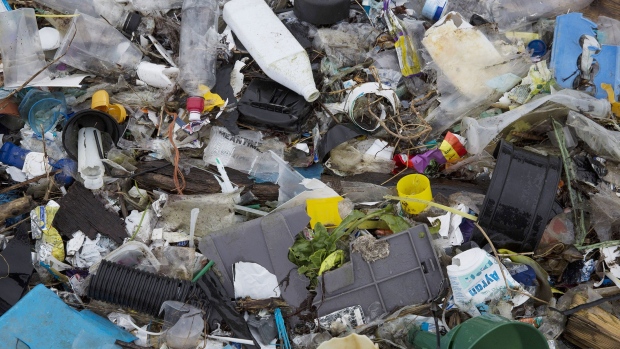Apr 23, 2020
Ridding the Oceans of Plastic Starts With Tracking It All Down
, Bloomberg News

(Bloomberg) -- For as long as there has been plastic garbage it’s managed to find its way into the ocean, but never quite like it did a couple of years ago off the Greek island of Lesbos. There, a team of people collected a small dump’s worth of plastic bottles, bags, and fishing nets, assembled it on platforms, and floated them (temporarily) out to sea.
The plastic barges were an experiment to see whether they’d be picked up by satellites and high-flying drones. The results, used in research published today in the journal Nature Scientific Reports, showed that satellites could pick up the agglomerations of plastic bobbing at sea. Using artificial intelligence, researchers were also able to discern trash from from natural materials like seaweed, wood, and even sea foam.
Spotting so-called “macroplastics” (bits, bags, and bottles larger than 5 millimeters) before they degrade into smaller particles has been attempted before. Until recently, however, satellites haven’t been able to produce images in enough detail and with enough frequency to accurately pinpoint and track plastic debris. Previously published estimates show that as much as 12.7 million metric tons gets dumped into the ocean each year.
Led by Lauren Biermann at Plymouth Marine Laboratory in the U.K., the study used images from the European Space Agency’s Sentinel-2 satellites, which take high-resolution images of much of the world every five days. The researchers developed a method to identify optical signatures from light wavelengths—both visible and infrared—of materials commonly found in debris patches. They used that information to train a machine learning algorithm, which was able to distinguish naturally occurring debris from plastic about 86% of the time in tests. Those were then validated against the images taken earlier of the plastic floats around Lesbos.
Biermann calls the work a step in bringing together marine plastics researchers and satellite-sensing experts. The approach can be used, she says, with any remote sensing platforms that operate in close to the same way as the Sentinel-2, including drones and other high-resolution satellites.
“Though this doesn't fix the marine plastics pollution problem,” she says, the large-scale views taken in by satellites and drones offer improved ways of “observing and tracking floating plastics, and we hope our work here will eventually support active clean-up operations.”
©2020 Bloomberg L.P.





